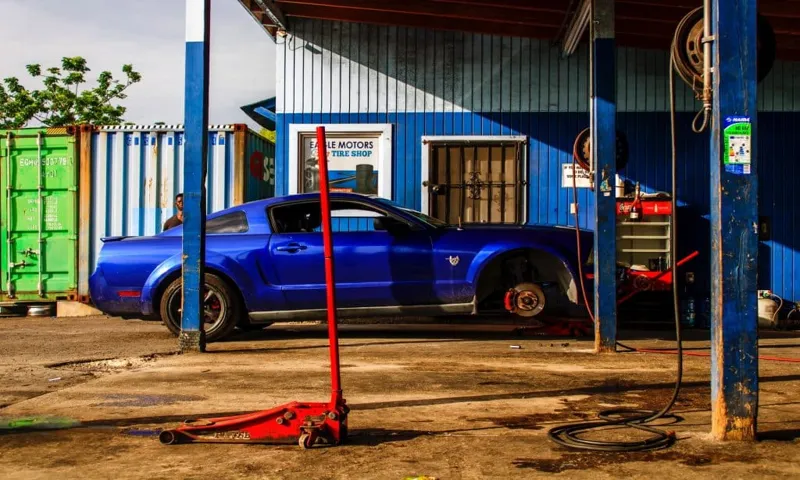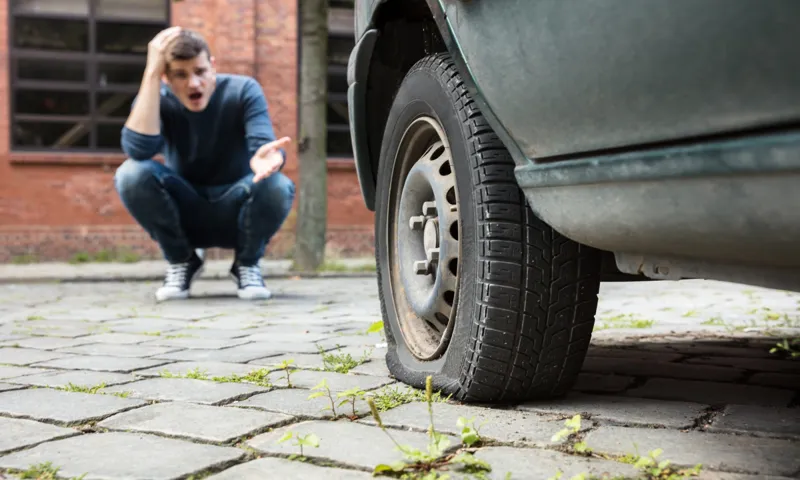Have you ever been driving down the road and suddenly feel the car start to pull to one side? You check your mirrors and see that one of your tires is significantly lower than the others. How did it happen? How long had it been slowly deflating unnoticed? How long does it take for a tire to go flat? Well, there’s no one-size-fits-all answer to this question as different factors can affect how long it takes for a tire to go flat. But on average, a tire can lose pressure at a rate of about 1-2 PSI per month due to small leaks or porousness in the rubber.
This means that if your tire is filled to 32 PSI, which is about average for most cars, it could take several months for it to noticeably lose pressure. However, if there is damage to the tire’s sidewall or tread, the loss of air pressure can happen much more quickly. Punctures from nails or screws are the most common causes of sudden deflation, as they create a hole that air can escape through rapidly.
It’s important to keep an eye on your tire pressure regularly to avoid driving on underinflated or flat tires. Underinflated tires can cause poor fuel economy, reduced handling and braking, and ultimately, premature tire wear. Plus, in extreme cases, driving on a flat tire can cause serious damage to your wheel and suspension.
So, as the saying goes, “an ounce of prevention is worth a pound of cure.” Check your tire pressure at least once a month, and whenever you suspect a leak or puncture, get it checked out by a professional as soon as possible.
Table of Contents
Causes of Flat Tires
If you’ve ever experienced a flat tire while driving, you know how inconvenient and stressful it can be. But have you ever wondered how long it takes for a tire to go flat and what causes it? There are several possible causes of flat tires, including punctures, valve stem damage, worn out or damaged tires, and excessive tire pressure. Punctures from nails, screws, or other sharp objects can cause slow leaks, while valve stem damage can cause sudden and rapid deflation.
Worn or damaged tires can also lead to flat tires as they become more susceptible to punctures and blowouts. Finally, excessive tire pressure can cause the tire to rupture, resulting in a flat tire. While there is no set time for a tire to go flat, regular tire maintenance and inspections can help prevent flat tires and extend the life of your tires.
Punctures and Blowouts
Punctures and blowouts can be frustrating and potentially dangerous issues faced by many drivers. Some common causes of flat tires include running over sharp objects like nails or shards of glass, hitting potholes or curbs, and wear and tear from daily use. Additionally, underinflation or overinflation of your tires can lead to abnormal wear, which can increase the likelihood of a blowout.
It’s important to regularly inspect your tires and ensure they are properly inflated and not experiencing any unusual wear. If you do find yourself with a flat tire, make sure to pull over to a safe location and change the tire or call for roadside assistance. Remember to never drive on a flat tire as it can cause irreparable damage to the wheel and compromise your safety on the road.

Valve Stem Issues
Valve stem issues are one of the most common causes of flat tires. The valve stem is a small but crucial part of your tire’s air pressure system, responsible for both inflating and deflating your tires. When the valve stem is damaged, it can cause air leaks which can lead to flat tires.
Some common causes of valve stem damage include corrosion, physical damage, and simply wear and tear over time. In some cases, improper installation or over-tightening of the valve stem can also cause it to fail. To avoid valve stem issues, it is important to make sure your tires are properly inflated and to check for any signs of wear or damage on the valve stem during routine maintenance checks.
Regularly inspecting and replacing valve stems when necessary can help prevent unexpected flats and keep you safe on the road.
Rim Leaks and Bead Seating
Flat tires are a common and frustrating problem for motorists, and one of the causes of this issue can be rim leaks and bead seating. Rim leaks occur when there are small gaps or cracks between the rim and the tire, allowing air to slowly escape over time. This can be caused by corrosion, damage, or even improper installation.
Bead seating, on the other hand, is the process of properly aligning the tire bead with the rim so that it forms an airtight seal. If this seal is not formed correctly, air can escape from the tire, causing it to go flat. This can happen due to factors such as overinflation or underinflation, debris or dirt on the rim or bead, or even the type of tire being used.
In order to avoid flat tires caused by rim leaks and bead seating, it is crucial to regularly inspect and maintain your tires and rims, ensuring they are properly installed and inflated to the correct pressure. By doing so, you can help prevent flat tires and keep your vehicle running smoothly on the road.
Factors Affecting Flat Tire Timeframe
Have you ever wondered how long it takes for a tire to go flat? It’s a common question among car owners, and the answer isn’t always straightforward. There are several factors that can affect the timeframe of a tire going flat. One of the main factors is the type of tire itself.
Different types of tires, such as run-flat or regular, may have varying lifespans. Another factor is the condition of the tire itself. A tire that is old, worn, or has been damaged is more likely to go flat sooner than a newer, well-maintained tire.
External factors, such as extreme temperatures, road conditions, and poor driving habits, can also contribute to a tire going flat. Ultimately, it’s important to regularly check your tire pressure and keep up with tire maintenance to ensure a longer lifespan and prevent unexpected flat tires.
Tire Pressure and Load
Maintaining proper tire pressure is a crucial factor in prolonging the lifespan of your tires. It’s essential to ensure that your tires are inflated to the manufacturer’s recommended pressure, as under-inflated or over-inflated tires can lead to a shorter lifespan and a higher risk of flats. Moreover, the load on your tires also affects the time frame for a flat tire.
The more weight your tires carry, the more quickly they will wear down and the greater the chance of a flat tire. It’s vital to make sure you are not overloading your vehicle or exceeding its recommended weight capacity. By paying attention to your tire pressure and load, you can prevent unnecessary flats and ensure a longer life for your tires.
Remember, your tires are the only part of your vehicle that has direct contact with the road, so taking care of them is essential for your safety on the road.
Tire Type and Quality
When it comes to the time period between flat tires, the type and quality of your tires play a crucial role. Tires designed for off-roading may be more durable, but they can also be harder to maneuver on paved roads, whereas tires designed for city driving are typically smoother, but may not last as long in rocky or uneven terrain. Additionally, the quality of the tire construction can greatly affect its lifespan and resistance to punctures.
Premium tire brands tend to invest in higher quality materials and technology to produce tires with greater durability and fewer flat tire occurrences. However, it is important to note that even the best quality tires will eventually wear down and require replacement. To extend your tire’s lifespan, make sure to keep them properly inflated, avoid overloading your vehicle, and regularly rotating your tires to ensure even wear.
By investing in high-quality tires and practicing proper maintenance, you can greatly reduce the frequency of flat tire occurrences and ensure a smoother, safer ride.
Road Conditions and Temperature
When it comes to getting a flat tire, there are a variety of factors that can contribute to how long you can go without experiencing one. One of the biggest factors is the condition of the roads you’re driving on. Potholes, uneven surfaces, and debris can all increase your chances of a flat tire.
Additionally, the temperature can also play a role. As temperatures rise and fall, so does the air pressure in your tires. If you fail to maintain proper inflation levels, you’re more likely to experience a flat.
Of course, how you drive also plays a role. Aggressive driving can put additional stress on your tires, causing them to wear down more quickly than they would under normal circumstances. So, if you want to avoid a flat tire, be sure to keep an eye on the condition of the roads you’ll be driving on, maintain proper inflation levels, and drive responsibly.
By doing so, you’ll minimize your chances of experiencing a flat and ensure a safer and smoother ride.
Typical Flat Tire Timeframe
One of the most frustrating scenarios any driver can face is a flat tire, especially when it happens in the middle of a journey. But how long does it take for a tire to go flat? The answer can vary depending on several factors such as the type of tire, its age, and the extent of the damage. In some cases, a tire can lose air pressure rapidly, within minutes or even seconds due to severe cuts or punctures, while in others, it may slowly deflate over several days or weeks because of valve stem leaks or slow punctures.
It is important to regularly check your tire pressure and examine your tires for any signs of damage to avoid getting stranded on the side of the road with a flat tire.
Slow Leaks
When it comes to flat tires, slow leaks are a common issue that many drivers face. These leaks can take anywhere from a few days to a few weeks to cause a tire to go completely flat. In fact, most slow leaks are so gradual that drivers may not even realize their tire is losing air until it’s too late.
This is why it’s important to regularly check your tire pressure, especially if you’ve noticed any signs of a slow leak such as a tire that looks slightly deflated or a dashboard warning light that won’t go away. By catching a slow leak early, you can prevent a flat tire from occurring and avoid the hassle of changing a tire on the side of the road.
Sudden Blows and Punctures
If you’re reading this, then you’re probably wondering how long it typically takes for a flat tire to happen. Well, it all depends on the circumstances. If you run over a sharp object, like a nail or a piece of glass, then the tire can go flat instantly.
However, if there’s a slow leak in the tire, then it may take some time before you notice any problems. It’s important to keep an eye on your tire pressure and have your tires inspected regularly to avoid sudden blows and punctures. Don’t get caught off guard–be proactive about your tire maintenance!
Flat Tire Prevention Measures
If you’re wondering how long it takes for a tire to go flat, it really depends on a number of factors. The most common cause of a flat tire is a puncture, which can happen from a nail or shard of glass. However, tires can also lose air over time due to a slow leak or from damage to the tire sidewall.
Getting a flat tire can be frustrating, inconvenient, and even dangerous, especially if you’re stranded on the side of the road. To avoid this, there are a few steps you can take to prevent flat tires. First, make sure your tires are properly inflated and have enough tread.
This will not only help prevent punctures but also improve your vehicle’s handling and fuel efficiency. Second, avoid driving over debris or potholes whenever possible. Finally, consider investing in tire sealant or run-flat tires, which can help keep your tires from going flat in the first place.
By taking these precautions, you can minimize the risk of a flat tire and keep your vehicle running smoothly.
Conclusion
In conclusion, the answer to the question “how long does it take a tire to go flat?” is not as simple as one may think. It depends on various factors such as the tire’s condition, the road conditions, the weight it’s carrying, and even the temperature. However, one thing is for sure – a flat tire can deflate your plans and leave you stranded.
So, make sure to check your tires regularly and keep them properly inflated to ensure a smooth ride. Because let’s face it, nobody has time for a flat tire, except for maybe a procrastinating sloth, but who wants to be like a sloth? Keep your tires inflated and your life moving forward.”
FAQs
What are some common causes of a tire going flat?
There are several common causes of a tire going flat including punctures from nails or other sharp objects, leaky valve stems, and damage to the tire from hitting a curb or other obstacle.
How often should I check my tire pressure to avoid a flat?
It is recommended to check your tire pressure at least once a month to prevent flats and ensure proper tire performance.
Can driving on a flat tire cause damage to my vehicle?
Yes, driving on a flat tire can cause significant damage to your vehicle’s rims and suspension system, which can be expensive to repair.
How long can I drive on a tire with a slow leak before it goes completely flat?
It is not recommended to continue driving on a tire with a slow leak, as it can lead to a blowout. It is best to get the tire repaired or replaced as soon as possible.
What should I do if my tire goes flat while I’m driving?
If your tire goes flat while you’re driving, it’s important to pull over to a safe location as soon as possible and have the tire repaired or replaced.
How much does it typically cost to repair a flat tire?
The cost of repairing a flat tire can vary depending on the severity of the damage, but it generally ranges from $20 to $40.
Is it safe to drive on a repaired tire?
Yes, a properly repaired tire can be just as safe to drive on as a new tire. It’s important to have the tire repaired by a professional and only if the damage is located in the tread area and is not too severe.



